Portal:Classical music
Portal maintenance status: (June 2018)
|
The Classical Music Portal
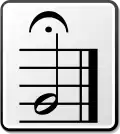

Classical music generally refers to the art music of the Western world, considered to be distinct from Western folk music or popular music traditions. It is sometimes distinguished as Western classical music, as the term "classical music" can also be applied to non-Western art musics. Classical music is often characterized by formality and complexity in its musical form and harmonic organization, particularly with the use of polyphony. Since at least the ninth century, it has been primarily a written tradition, spawning a sophisticated notational system, as well as accompanying literature in analytical, critical, historiographical, musicological and philosophical practices. A foundational component of Western culture, classical music is frequently seen from the perspective of individual or groups of composers, whose compositions, personalities and beliefs have fundamentally shaped its history. (Full article...)
Selected articles -
-
 Image 1A countertenor (also contra tenor) is a type of classical male singing voice whose vocal range is equivalent to that of the female contralto or mezzo-soprano voice types, generally extending from around G3 to D5 or E5, although a sopranist (a specific kind of countertenor) may match the soprano's range of around C4 to C6. Countertenors often have tenor or baritone chest voices, but sing in falsetto or head voice much more often than they do in their chest voice.
Image 1A countertenor (also contra tenor) is a type of classical male singing voice whose vocal range is equivalent to that of the female contralto or mezzo-soprano voice types, generally extending from around G3 to D5 or E5, although a sopranist (a specific kind of countertenor) may match the soprano's range of around C4 to C6. Countertenors often have tenor or baritone chest voices, but sing in falsetto or head voice much more often than they do in their chest voice.
The nature of the countertenor voice has radically changed throughout musical history, from a modal voice, to a modal and falsetto voice, to the primarily falsetto voice that is denoted by the term today. This is partly because of changes in human physiology (increase in body height) and partly because of fluctuations in pitch. (Full article...) -
 Image 2
Image 2 Johann Christoph von Ponickau, for whose memorial service the cantata was composed
Johann Christoph von Ponickau, for whose memorial service the cantata was composed
Ich lasse dich nicht, du segnest mich denn (I will not let you go, unless you bless me), BWV 157, is a church cantata by Johann Sebastian Bach. He composed it in Leipzig in 1726/27 to a libretto by Picander. The first known performance was on 6 February 1727 during a memorial service for Johann Christoph von Ponickau in Pomßen near Leipzig. The work was later assigned to the feast of the Purification celebrated on 2 February.
Picander included a quotation from Genesis 32:26–32 in the first movement, and the last stanza of Christian Keymann's "Meinen Jesum laß ich nicht" in the closing chorale. The contemplation begins with the Old Testament quotation being applied to Jesus, and leads to the last aria expressing an eager wish for death to arrive soon. The closing chorale picks up the first line. (Full article...) -
![Image 3 Antonio Stradivari (/ˌstrædɪˈvɑːri/, also US: /-ˈvɛəri/, Italian: [anˈtɔːnjo stradiˈvaːri]; c. 1644 – 18 December 1737) was an Italian luthier and a craftsman of string instruments such as violins, cellos, guitars, violas and harps. The Latinized form of his surname, Stradivarius, as well as the colloquial Strad are terms often used to refer to his instruments. It is estimated that Stradivari produced 1,116 instruments, of which 960 were violins. Around 650 instruments survive, including 450 to 512 violins. His instruments are considered some of the finest ever made, and are extremely valuable collector's items. (Full article...)](./_assets_/Blank.png) Image 3
Image 3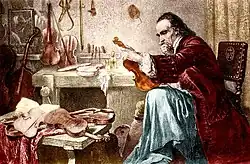
Antonio Stradivari (/ˌstrædɪˈvɑːri/, also US: /-ˈvɛəri/, Italian: [anˈtɔːnjo stradiˈvaːri]; c. 1644 – 18 December 1737) was an Italian luthier and a craftsman of string instruments such as violins, cellos, guitars, violas and harps. The Latinized form of his surname, Stradivarius, as well as the colloquial Strad are terms often used to refer to his instruments. It is estimated that Stradivari produced 1,116 instruments, of which 960 were violins. Around 650 instruments survive, including 450 to 512 violins. His instruments are considered some of the finest ever made, and are extremely valuable collector's items. (Full article...) -
 Image 4
Image 4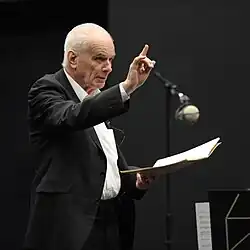 Davies in 2012
Davies in 2012
Sir Peter Maxwell Davies CH CBE (8 September 1934 – 14 March 2016) was an English composer and conductor, who in 2004 was made Master of the Queen's Music.
As a student at both the University of Manchester and the Royal Manchester College of Music, Davies formed a group dedicated to contemporary music called the New Music Manchester with fellow students Harrison Birtwistle, Alexander Goehr, Elgar Howarth and John Ogdon. Davies's compositions include eight works for the stage—from the monodrama Eight Songs for a Mad King, which shocked the audience in 1969, to Kommilitonen!, first performed in 2011—and ten symphonies, written between 1973 and 2013. (Full article...) -
![Image 5 Portrait of Haydn by Thomas Hardy, c. 1791 Franz Joseph Haydn (/ˈhaɪdən/ HY-dən; German: [ˈfʁants ˈjoːzɛf ˈhaɪdn̩] ⓘ; 31 March 1732 – 31 May 1809) was an Austrian composer of the Classical period. He was instrumental in the development of chamber music such as the string quartet and piano trio. His contributions to musical form have led him to be called "Father of the Symphony" and "Father of the String quartet". Haydn arose from humble origins, the child of working people in a rural village. He established his career first by serving as a chorister at St. Stephen's Cathedral, Vienna, then through an arduous period as a freelance musician. Eventually he found career success, spending much of his working life as music director for the wealthy Esterházy family at their palace of Eszterháza in rural Hungary. Though he had his own orchestra there, it isolated him from other composers and trends in music so that he was, as he put it, "forced to become original". During this period his music circulated widely in publication, eventually making him the most celebrated composer in Europe. With the death of his primary patron Nikolaus Esterházy in 1790, Haydn was free to travel, and augmented his fame—now as a performer before the public—in both London and Vienna. The last years of his life (1803–1809) were spent in a state of debility, unable to compose due to poor health. He died in Vienna in 1809 at the age of 77. (Full article...)](./_assets_/Blank.png) Image 5
Image 5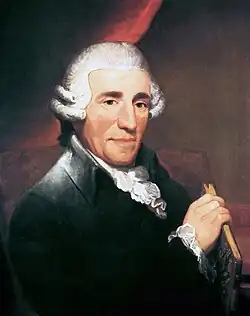
Portrait of Haydn by Thomas Hardy, c. 1791
Franz Joseph Haydn (/ˈhaɪdən/ HY-dən; German: [ˈfʁants ˈjoːzɛf ˈhaɪdn̩] ⓘ; 31 March 1732 – 31 May 1809) was an Austrian composer of the Classical period. He was instrumental in the development of chamber music such as the string quartet and piano trio. His contributions to musical form have led him to be called "Father of the Symphony" and "Father of the String quartet".
Haydn arose from humble origins, the child of working people in a rural village. He established his career first by serving as a chorister at St. Stephen's Cathedral, Vienna, then through an arduous period as a freelance musician. Eventually he found career success, spending much of his working life as music director for the wealthy Esterházy family at their palace of Eszterháza in rural Hungary. Though he had his own orchestra there, it isolated him from other composers and trends in music so that he was, as he put it, "forced to become original". During this period his music circulated widely in publication, eventually making him the most celebrated composer in Europe. With the death of his primary patron Nikolaus Esterházy in 1790, Haydn was free to travel, and augmented his fame—now as a performer before the public—in both London and Vienna. The last years of his life (1803–1809) were spent in a state of debility, unable to compose due to poor health. He died in Vienna in 1809 at the age of 77. (Full article...) -
 Image 6
Image 6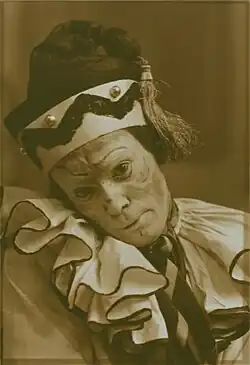 Nijinsky as Petrushka
Nijinsky as Petrushka
Petrushka (French: Pétrouchka; Russian: Петрушка) is a ballet by Russian composer Igor Stravinsky. It was written for the 1911 Paris season of Sergei Diaghilev's Ballets Russes company; the original choreography was by Michel Fokine and stage designs and costumes by Alexandre Benois, who assisted Stravinsky with the libretto. The ballet premiered at the Théâtre du Châtelet on 13 June 1911 with Vaslav Nijinsky as Petrushka, Tamara Karsavina as the lead ballerina, Alexander Orlov as the Moor, and Enrico Cecchetti the charlatan.
Petrushka tells the story of the loves and jealousies of three puppets. The three are brought to life by the Charlatan during the 1830 Shrovetide Fair (Maslenitsa) in Saint Petersburg. Petrushka is in love with the Ballerina, but she rejects him as she prefers the Moor. Petrushka is angry and hurt, and curses the Charlatan for bringing him into the world with only pain and suffering in his miserable life. Because of his anger, he challenges the Moor as a result. The Moor, who is both bigger and stronger than Petrushka, kills him with his sword (scimitar). The crowd watching is horrified, and the Charlatan is called to the scene as well as a police officer. The Charlatan reminds everyone that Petrushka is nothing but a puppet made of straw and cloth, and that he has no real emotion nor 'life'. As the crowd disperses, the Charlatan is left alone on the stage. At that moment, Petrushka's ghost rises above the puppet theatre as night falls. He shakes his fist and thumbs his nose at the Charlatan, making him flee, terrified. Petrushka then collapses in a second death. (Full article...) -
![Image 7 Cover of a 1921 libretto for Giordano's Andrea Chénier A libretto (From the Italian word libretto, lit. 'booklet') is the text used in, or intended for, an extended musical work such as an opera, operetta, masque, oratorio, cantata or musical. The term libretto is also sometimes used to refer to the text of major liturgical works, such as the Mass, requiem and sacred cantata, or the story line of a ballet. The Italian word libretto (pronounced [liˈbretto], plural libretti [liˈbretti]) is the diminutive of the word libro ("book"). Sometimes other-language equivalents are used for libretti in that language, livret for French works, Textbuch for German and libreto for Spanish. A libretto is distinct from a synopsis or scenario of the plot, in that the libretto contains all the words and stage directions, while a synopsis summarizes the plot. Some ballet historians also use the word libretto to refer to the 15- to 40-page books which were on sale to 19th century ballet audiences in Paris and contained a very detailed description of the ballet's story, scene by scene. (Full article...)](./_assets_/Blank.png) Image 7
Image 7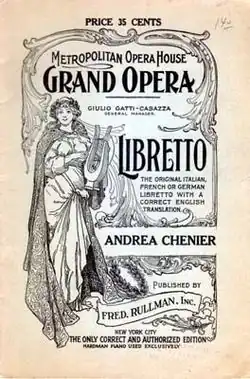
Cover of a 1921 libretto for Giordano's Andrea Chénier
A libretto (From the Italian word libretto, lit. 'booklet') is the text used in, or intended for, an extended musical work such as an opera, operetta, masque, oratorio, cantata or musical. The term libretto is also sometimes used to refer to the text of major liturgical works, such as the Mass, requiem and sacred cantata, or the story line of a ballet.
The Italian word libretto (pronounced [liˈbretto], plural libretti [liˈbretti]) is the diminutive of the word libro ("book"). Sometimes other-language equivalents are used for libretti in that language, livret for French works, Textbuch for German and libreto for Spanish. A libretto is distinct from a synopsis or scenario of the plot, in that the libretto contains all the words and stage directions, while a synopsis summarizes the plot. Some ballet historians also use the word libretto to refer to the 15- to 40-page books which were on sale to 19th century ballet audiences in Paris and contained a very detailed description of the ballet's story, scene by scene. (Full article...) -
![Image 8 Original 1904 poster by Adolfo Hohenstein Madama Butterfly (Italian pronunciation: [maˈdaːma ˈbatterflai]; Madame Butterfly) is an opera in three acts (originally two) by Giacomo Puccini, with an Italian libretto by Luigi Illica and Giuseppe Giacosa. It is based on the short story "Madame Butterfly" (1898) by John Luther Long, which in turn was based on stories told to Long by his sister Jennie Correll and on the semi-autobiographical 1887 French novel Madame Chrysanthème by Pierre Loti. Long's version was dramatized by David Belasco as the one-act play Madame Butterfly: A Tragedy of Japan, which, after premiering in New York in 1900, moved to London, where Puccini saw it in the summer of that year. (Full article...)](./_assets_/Blank.png) Image 8
Image 8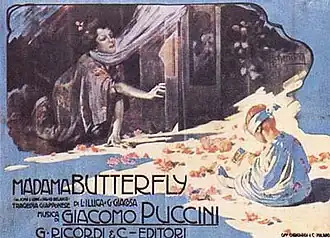 Original 1904 poster by Adolfo Hohenstein
Original 1904 poster by Adolfo Hohenstein
Madama Butterfly (Italian pronunciation: [maˈdaːma ˈbatterflai]; Madame Butterfly) is an opera in three acts (originally two) by Giacomo Puccini, with an Italian libretto by Luigi Illica and Giuseppe Giacosa.
It is based on the short story "Madame Butterfly" (1898) by John Luther Long, which in turn was based on stories told to Long by his sister Jennie Correll and on the semi-autobiographical 1887 French novel Madame Chrysanthème by Pierre Loti. Long's version was dramatized by David Belasco as the one-act play Madame Butterfly: A Tragedy of Japan, which, after premiering in New York in 1900, moved to London, where Puccini saw it in the summer of that year. (Full article...) -
 Image 9
Image 9
Bagpiper, by Abraham Bloemaert
A musical instrument is a device created or adapted to make musical sounds. In principle, any object that produces sound can be considered a musical instrument—it is through purpose that the object becomes a musical instrument. A person who plays a musical instrument is known as an instrumentalist.
The history of musical instruments dates to the beginnings of human culture. Early musical instruments may have been used for rituals, such as a horn to signal success on the hunt, or a drum in a religious ceremony. Cultures eventually developed composition and performance of melodies for entertainment. Musical instruments evolved in step with changing applications and technologies. (Full article...) -
 Image 10
Image 10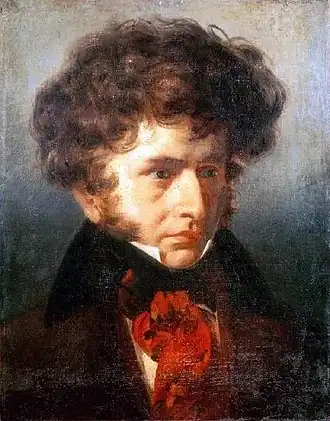 Hector Berlioz
Hector Berlioz
Symphonie fantastique: Épisode de la vie d'un artiste … en cinq parties (Fantastic Symphony: Episode in the Life of an Artist … in Five Sections) Op. 14, is a programmatic symphony written by Hector Berlioz in 1830. The first performance was at the Paris Conservatoire on 5 December 1830.
Berlioz wrote semi-autobiographical programme notes for the piece that allude to the romantic sufferings of a gifted artist who has poisoned himself with opium because of his unrequited love for a beautiful and fascinating woman (in real life, the Shakespearean actress Harriet Smithson, who in 1833 became the composer's wife). The composer, who revered Beethoven, followed the latter's unusual addition in the Pastoral Symphony of a fifth movement to the normal four of a classical symphony. The artist's reveries take him to a ball and to a pastoral scene in a field, which is interrupted by a hallucinatory march to the scaffold, leading to a grotesque satanic dance (Witches' Sabbath). Within each episode, the artist's passion is represented by a recurring theme called the idée fixe. (Full article...) -
 Image 11
Image 11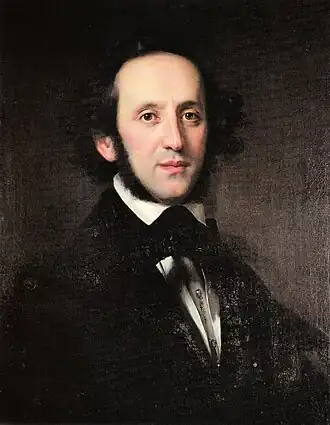 Mendelssohn in 1846 by Eduard Magnus
Mendelssohn in 1846 by Eduard Magnus
Felix Mendelssohn's Violin Concerto in E minor, Op. 64, MWV O 14, is his last concerto. It was well received at its premiere and has remained as one of the most prominent and highly-regarded violin concertos in history. It holds a central place in violin repertoire and has developed a reputation as an essential concerto for all aspiring concert violinists to master. A typical performance lasts just under half an hour.
Mendelssohn originally proposed the idea of the violin concerto to Ferdinand David, a close friend and concertmaster of the Leipzig Gewandhaus Orchestra. Although conceived in 1838, the work took another six years to complete and was not premiered until 1845. During this time, Mendelssohn maintained a regular correspondence with David as he gave him many suggestions throughout the creation process. The work itself was one of the foremost violin concertos of the Romantic era and was influential on many other composers. (Full article...) -
 Image 12
Image 12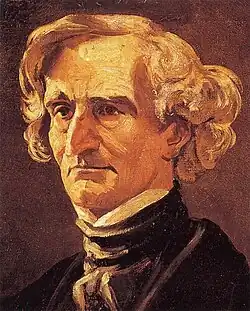
Hector Berlioz was the first to use the term "choral symphony" for a musical composition—his Roméo et Juliette.
A choral symphony is a musical composition for orchestra, choir, and sometimes solo vocalists that, in its internal workings and overall musical architecture, adheres broadly to symphonic musical form. The term "choral symphony" in this context was coined by Hector Berlioz when he described his Roméo et Juliette as such in his five-paragraph introduction to that work. The direct antecedent for the choral symphony is Ludwig van Beethoven's Ninth Symphony. Beethoven's Ninth incorporates part of the ode An die Freude ("Ode to Joy"), a poem by Friedrich Schiller, with text sung by soloists and chorus in the last movement. It is the first example of a major composer's use of the human voice on the same level as instruments in a symphony.
A few 19th-century composers, notably Felix Mendelssohn and Franz Liszt, followed Beethoven in producing choral symphonic works. Notable works in the genre were produced in the 20th century by Gustav Mahler, Igor Stravinsky, Ralph Vaughan Williams, Benjamin Britten and Dmitri Shostakovich, among others. The final years of the 20th century and the opening of the 21st century have seen several new works in this genre, among them compositions by Mikis Theodorakis, Peter Maxwell Davies, Tan Dun, Philip Glass, Hans Werner Henze, Krzysztof Penderecki, William Bolcom and Robert Strassburg. (Full article...)
General images -
-
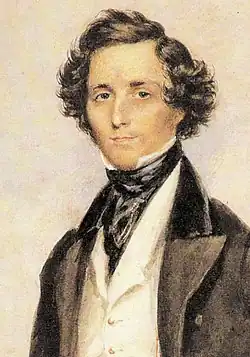
-
Image 2Josef Danhauser's 1840 painting of Franz Liszt at the piano surrounded by (from left to right) Alexandre Dumas, Hector Berlioz, George Sand, Niccolò Paganini, Gioachino Rossini and Marie d'Agoult, with a bust of Ludwig van Beethoven on the piano (from Romantic music)
-
 Image 3A large instrumental ensemble's performance in the lavish Teatro Argentina, as depicted by Panini (1747) (from Baroque music)
Image 3A large instrumental ensemble's performance in the lavish Teatro Argentina, as depicted by Panini (1747) (from Baroque music) -
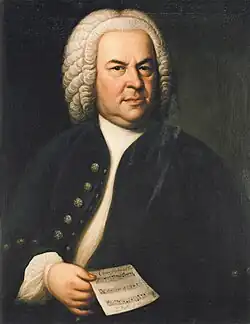
-
 Image 5Wanderer above the Sea of Fog, by Caspar David Friedrich, is an example of Romantic painting. (from Romantic music)
Image 5Wanderer above the Sea of Fog, by Caspar David Friedrich, is an example of Romantic painting. (from Romantic music) -
 Image 6The opening bars of the Commendatore's aria in Mozart's opera Don Giovanni. The orchestra starts with a dissonant diminished seventh chord (G# dim7 with a B in the bass) moving to a dominant seventh chord (A7 with a C# in the bass) before resolving to the tonic chord (D minor) at the singer's entrance. (from Classical period (music))
Image 6The opening bars of the Commendatore's aria in Mozart's opera Don Giovanni. The orchestra starts with a dissonant diminished seventh chord (G# dim7 with a B in the bass) moving to a dominant seventh chord (A7 with a C# in the bass) before resolving to the tonic chord (D minor) at the singer's entrance. (from Classical period (music)) -
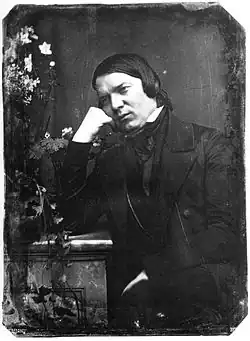
-
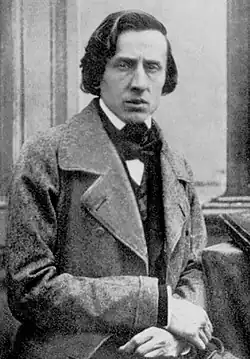
-
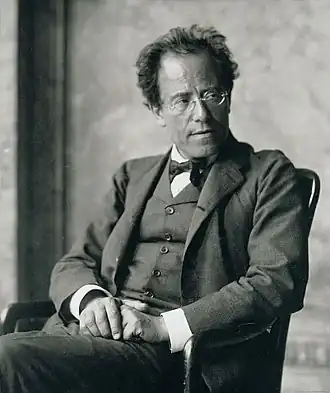 Image 9Gustav Mahler, photographed in 1907 by Moritz Nähr at the end of his period as director of the Vienna Hofoper (from Romantic music)
Image 9Gustav Mahler, photographed in 1907 by Moritz Nähr at the end of his period as director of the Vienna Hofoper (from Romantic music) -
 Image 10Hummel in 1814 (from Classical period (music))
Image 10Hummel in 1814 (from Classical period (music)) -
 Image 11Gluck, detail of a portrait by Joseph Duplessis, dated 1775 (Kunsthistorisches Museum, Vienna) (from Classical period (music))
Image 11Gluck, detail of a portrait by Joseph Duplessis, dated 1775 (Kunsthistorisches Museum, Vienna) (from Classical period (music)) -
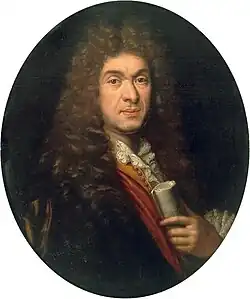
-
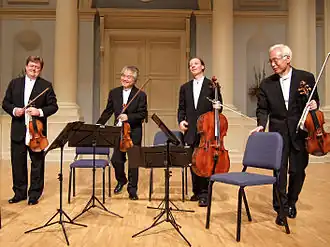 Image 13A modern string quartet. In the 2000s, string quartets from the Classical era are the core of the chamber music literature. From left to right: violin 1, violin 2, cello, viola (from Classical period (music))
Image 13A modern string quartet. In the 2000s, string quartets from the Classical era are the core of the chamber music literature. From left to right: violin 1, violin 2, cello, viola (from Classical period (music)) -
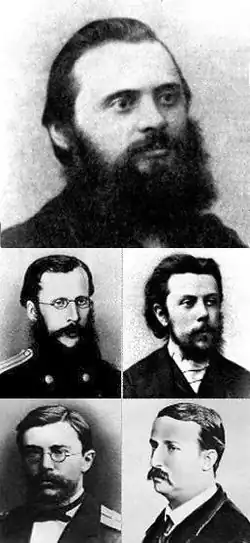 Image 14Balakirev (top), Cui (upper left), Mussorgsky (upper right), Rimsky-Korsakov (lower left), and Borodin (lower right). (from Romantic music)
Image 14Balakirev (top), Cui (upper left), Mussorgsky (upper right), Rimsky-Korsakov (lower left), and Borodin (lower right). (from Romantic music) -
 Image 15Gerard van Honthorst, The Concert (1623), National Gallery of Art, Washington D.C. (from Renaissance music)
Image 15Gerard van Honthorst, The Concert (1623), National Gallery of Art, Washington D.C. (from Renaissance music) -
 Image 16Double-manual harpsichord by Vital Julian Frey, after Jean-Claude Goujon (1749) (from Baroque music)
Image 16Double-manual harpsichord by Vital Julian Frey, after Jean-Claude Goujon (1749) (from Baroque music) -
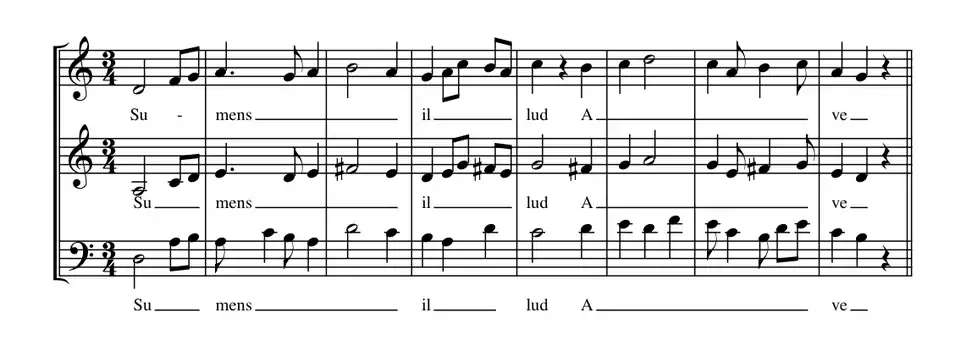 Image 17Portion of Du Fay's setting of Ave maris stella, in fauxbourdon. The top line is a paraphrase of the chant; the middle line, designated "fauxbourdon", (not written) follows the top line but exactly a perfect fourth below. The bottom line is often, but not always, a sixth below the top line; it is embellished, and reaches cadences on the octave.Play (from Renaissance music)
Image 17Portion of Du Fay's setting of Ave maris stella, in fauxbourdon. The top line is a paraphrase of the chant; the middle line, designated "fauxbourdon", (not written) follows the top line but exactly a perfect fourth below. The bottom line is often, but not always, a sixth below the top line; it is embellished, and reaches cadences on the octave.Play (from Renaissance music) -
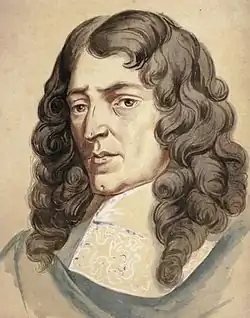 Image 18Marc-Antoine Charpentier (from Baroque music)
Image 18Marc-Antoine Charpentier (from Baroque music) -
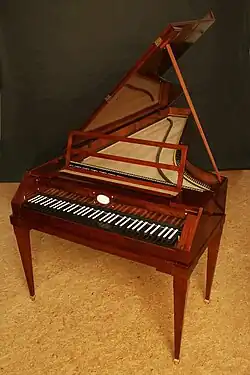 Image 19Fortepiano by Paul McNulty after Walter & Sohn, c. 1805 (from Classical period (music))
Image 19Fortepiano by Paul McNulty after Walter & Sohn, c. 1805 (from Classical period (music)) -
 Image 20Painting by Evaristo Baschenis of Baroque instruments, including a cittern, viola da gamba, violin, and two lutes (from Baroque music)
Image 20Painting by Evaristo Baschenis of Baroque instruments, including a cittern, viola da gamba, violin, and two lutes (from Baroque music) -
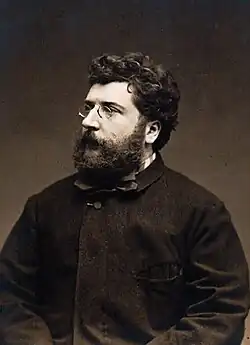
-
.jpg) Image 22Individual sheet music for a seventeenth-century harp. (from Baroque music)
Image 22Individual sheet music for a seventeenth-century harp. (from Baroque music) -
 Image 23Wolfgang Amadeus Mozart, posthumous painting by Barbara Krafft in 1819 (from Classical period (music))
Image 23Wolfgang Amadeus Mozart, posthumous painting by Barbara Krafft in 1819 (from Classical period (music)) -
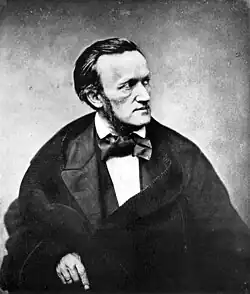 Image 24Richard Wagner in Paris, 1861
Image 24Richard Wagner in Paris, 1861 -
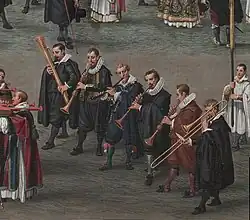 Image 25Musicians from 'Procession in honour of Our Lady of Sablon in Brussels.' Early 17th-century Flemish alta cappella. From left to right: bass dulcian, alto shawm, treble cornett, soprano shawm, alto shawm, tenor sackbut. (from Renaissance music)
Image 25Musicians from 'Procession in honour of Our Lady of Sablon in Brussels.' Early 17th-century Flemish alta cappella. From left to right: bass dulcian, alto shawm, treble cornett, soprano shawm, alto shawm, tenor sackbut. (from Renaissance music) -
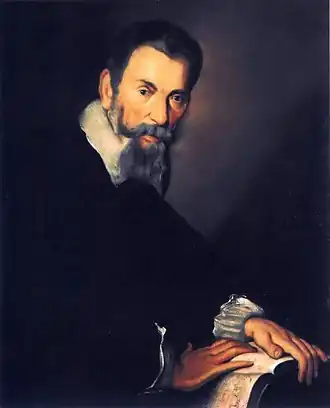
-
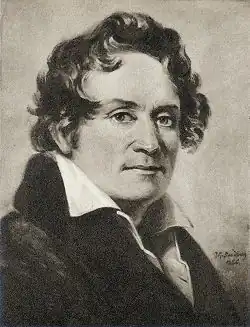 Image 27Bernhard Crusell, a Swedish-Finnish composer and clarinetist, in 1826 (from Classical period (music))
Image 27Bernhard Crusell, a Swedish-Finnish composer and clarinetist, in 1826 (from Classical period (music)) -
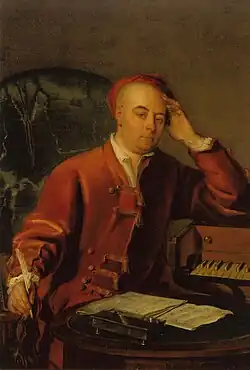
-
.jpg)
-
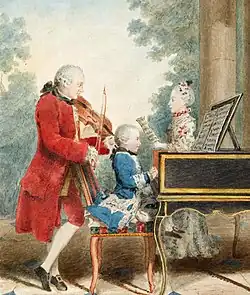 Image 30Wolfgang Amadeus Mozart, a representative composer of the Classical period, seated at a keyboard. (from Classical period (music))
Image 30Wolfgang Amadeus Mozart, a representative composer of the Classical period, seated at a keyboard. (from Classical period (music)) -

-
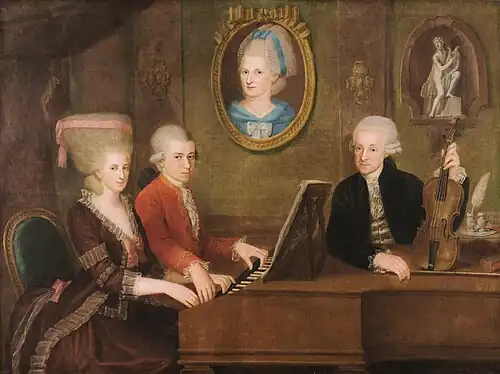
-
 Image 331875 oil painting of Franz Schubert by Wilhelm August Rieder, after his own 1825 watercolor portrait (from Classical period (music))
Image 331875 oil painting of Franz Schubert by Wilhelm August Rieder, after his own 1825 watercolor portrait (from Classical period (music)) -

-
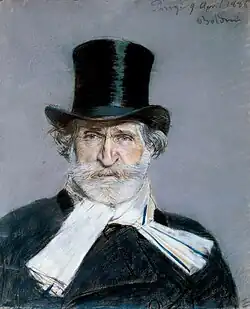
-
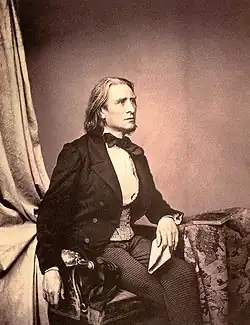
-

-
 Image 38Selection of Renaissance instruments (from Renaissance music)
Image 38Selection of Renaissance instruments (from Renaissance music)
Quotes -
| “ | Music is, by its very nature, essentially powerless to express anything at all. | ” |
| — Igor Stravinsky | ||
Related portals
WikiProjects
| WikiProject Classical music | WikiProject Composers | WikiProject Contemporary music |
|---|---|---|
| WikiProject Opera | WikiProject Richard Wagner | WikiProject Gilbert and Sullivan |
 Selected composers -
Selected composers - 
-
 Image 1
Image 1.jpg)
Delius, photographed in 1907
Frederick Theodore Albert Delius CH (born Fritz Theodor Albert Delius; /ˈdiːliəs/; 29 January 1862 – 10 June 1934) was an English composer. Born in Bradford in the north of England to a prosperous mercantile family, he resisted attempts to recruit him to commerce. He was sent to Florida in the United States in 1884 to manage an orange plantation. He soon neglected his managerial duties, and in 1886 returned to Europe.
Having been influenced by African-American music during his short stay in Florida, he began composing. After a brief period of formal musical study in Germany beginning in 1886, he embarked on a full-time career as a composer in Paris and then in nearby Grez-sur-Loing, where he and his wife Jelka lived for the rest of their lives, except during the First World War. (Full article...) -
 Image 2Valerie Muriel Rodway (February 12, 1919 – August 1970) was a Guyanese composer of cultural and patriotic songs, inspired by the events leading up to Guyana's independence in 1966. She is best known for composing music to accompany Guyana national poetry, like Arise, Guyana, Kanaïma, and the Martin Carter's Guyanese Independence poem Let Freedom Awaken. For the next two decades, school children were taught the songs she and others composed to inspire patriotism and cultural affinity. She selected the poetry for her compositions based upon her principles and values, first developed among her parents and siblings.
Image 2Valerie Muriel Rodway (February 12, 1919 – August 1970) was a Guyanese composer of cultural and patriotic songs, inspired by the events leading up to Guyana's independence in 1966. She is best known for composing music to accompany Guyana national poetry, like Arise, Guyana, Kanaïma, and the Martin Carter's Guyanese Independence poem Let Freedom Awaken. For the next two decades, school children were taught the songs she and others composed to inspire patriotism and cultural affinity. She selected the poetry for her compositions based upon her principles and values, first developed among her parents and siblings.
She has been considered Guyana's greatest composer of patriotic and national music, and among the best composers from Guyana of the 20th century, generally and among composers of classical music. She was awarded the Wordsworth McAndrew Award posthumously in 2002. In 2019, she was awarded the Cacique Crown of Honor, one of the highest honors of Guyana. The National Trust of Guyana building in Cummingsburg, Georgetown, has been renamed the Valerie Rodway House in her honor. (Full article...) -
![Image 3 Messager in 1921 André Charles Prosper Messager (French: [mɛsaʒe]; 30 December 1853 – 24 February 1929) was a French composer, organist, pianist and conductor. His compositions include eight ballets and thirty opéras comiques, opérettes and other stage works, among which his ballet Les Deux Pigeons (1886) and opéra comique Véronique (1898) have had lasting success; Les p'tites Michu (1897) and Monsieur Beaucaire (1919) were also popular internationally. Messager took up the piano as a small child and later studied composition with, among others, Camille Saint-Saëns and Gabriel Fauré. He became a major figure in the musical life of Paris and later London, both as a conductor and a composer. Many of his Parisian works were also produced in the West End and some on Broadway; the most successful had long runs and numerous international revivals. He wrote two operatic works in English, and his later output included musical comedies for Sacha Guitry and Yvonne Printemps. (Full article...)](./_assets_/Blank.png) Image 3
Image 3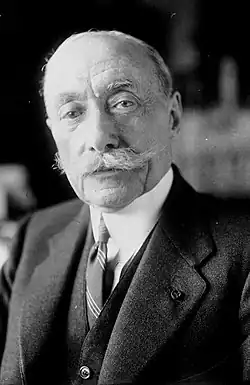
Messager in 1921 
André Charles Prosper Messager (French: [mɛsaʒe]; 30 December 1853 – 24 February 1929) was a French composer, organist, pianist and conductor. His compositions include eight ballets and thirty opéras comiques, opérettes and other stage works, among which his ballet Les Deux Pigeons (1886) and opéra comique Véronique (1898) have had lasting success; Les p'tites Michu (1897) and Monsieur Beaucaire (1919) were also popular internationally.
Messager took up the piano as a small child and later studied composition with, among others, Camille Saint-Saëns and Gabriel Fauré. He became a major figure in the musical life of Paris and later London, both as a conductor and a composer. Many of his Parisian works were also produced in the West End and some on Broadway; the most successful had long runs and numerous international revivals. He wrote two operatic works in English, and his later output included musical comedies for Sacha Guitry and Yvonne Printemps. (Full article...) -
![Image 4 Tōru Takemitsu (武満 徹; pronounced [takeꜜmitsɯ̥ toːɾɯ]; 8 October 1930 – 20 February 1996) was a Japanese composer and writer on aesthetics and music theory. Largely self-taught, Takemitsu was admired for the subtle manipulation of instrumental and orchestral timbre. He is known for combining elements of oriental and occidental philosophy and for fusing sound with silence and tradition with innovation. He composed several hundred independent works of music, scored more than ninety films and published twenty books. He was also a founding member of the Jikken Kōbō (Experimental Workshop) in Japan, a group of avant-garde artists who distanced themselves from academia and whose collaborative work is often regarded among the most influential of the 20th century. (Full article...)](./_assets_/Blank.png) Image 4Tōru Takemitsu (武満 徹; pronounced [takeꜜmitsɯ̥ toːɾɯ]; 8 October 1930 – 20 February 1996) was a Japanese composer and writer on aesthetics and music theory. Largely self-taught, Takemitsu was admired for the subtle manipulation of instrumental and orchestral timbre. He is known for combining elements of oriental and occidental philosophy and for fusing sound with silence and tradition with innovation.
Image 4Tōru Takemitsu (武満 徹; pronounced [takeꜜmitsɯ̥ toːɾɯ]; 8 October 1930 – 20 February 1996) was a Japanese composer and writer on aesthetics and music theory. Largely self-taught, Takemitsu was admired for the subtle manipulation of instrumental and orchestral timbre. He is known for combining elements of oriental and occidental philosophy and for fusing sound with silence and tradition with innovation.
He composed several hundred independent works of music, scored more than ninety films and published twenty books. He was also a founding member of the Jikken Kōbō (Experimental Workshop) in Japan, a group of avant-garde artists who distanced themselves from academia and whose collaborative work is often regarded among the most influential of the 20th century. (Full article...) -
 Image 5
Image 5
Imogen Clare Holst CBE (née von Holst; 12 April 1907 – 9 March 1984) was a British composer, arranger, conductor, teacher, musicologist and festival administrator. The only child of the composer Gustav Holst, she is particularly known for her educational work at Dartington Hall in the 1940s, and for her 20 years as joint artistic director of the Aldeburgh Festival. In addition to composing music, she wrote composer biographies, much educational material and several books on the life and works of her father.
From a young age Holst showed precocious talent in composing and performance. After attending Eothen School and St Paul's Girls' School, she entered the Royal College of Music, where she developed her skills as a conductor and won several prizes for composing. Unable to follow her initial ambitions to be a pianist or a dancer for health reasons, Holst spent most of the 1930s teaching, and as a full-time organiser for the English Folk Dance and Song Society. These duties reduced her compositional activities, although she made many arrangements of folksongs. After serving as an organiser for the Council for the Encouragement of Music and the Arts at the start of the Second World War, in 1942 she began working at Dartington. In her nine years there she established Dartington as a major centre of music education and activity. (Full article...) -
![Image 6 Mykola Leontovych Mykola Dmytrovych Leontovych (Ukrainian: Микола Дмитрович Леонтович, pronounced [mɪˈkɔlɐ ˈdmɪtrowɪtʃ leonˈtɔwɪtʃ] ⓘ; 13 December [O.S. 1 December] 1877 – 23 January 1921) was a Ukrainian composer, conductor, ethnomusicologist, and teacher. His music was inspired by the Ukrainian composer Mykola Lysenko and the Ukrainian National Music School. Leontovych specialised in a cappella choral music, ranging from original compositions to church music to elaborate arrangements of folk music. Leontovych was born and raised in Monastyrok in the Podolia province of the Russian Empire (now in Vinnytsia Oblast, Western Ukraine). He was educated as a priest in the Kamianets-Podilskyi Theological Seminary. With the independence of the Ukrainian State in the 1917 revolution, he moved to Kyiv, where he worked at the Kyiv Conservatory and the Mykola Lysenko Institute of Music and Drama. He composed "Shchedryk" in 1914 (premiered in 1916), now known to the English-speaking world as "Carol of the Bells". He was murdered by a Soviet agent in 1921 and is known as a martyr in the Eastern Orthodox Ukrainian Church, where he is also remembered for his liturgy, the first composed in the vernacular, specifically in the modern Ukrainian language. (Full article...)](./_assets_/Blank.png) Image 6
Image 6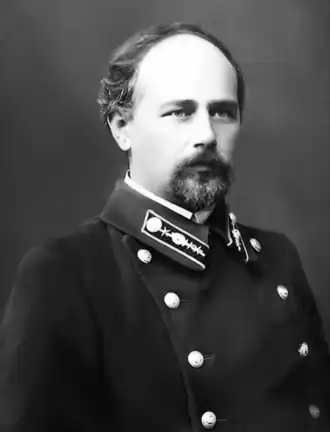
Mykola Leontovych
Mykola Dmytrovych Leontovych (Ukrainian: Микола Дмитрович Леонтович, pronounced [mɪˈkɔlɐ ˈdmɪtrowɪtʃ leonˈtɔwɪtʃ] ⓘ; 13 December [O.S. 1 December] 1877 – 23 January 1921) was a Ukrainian composer, conductor, ethnomusicologist, and teacher. His music was inspired by the Ukrainian composer Mykola Lysenko and the Ukrainian National Music School. Leontovych specialised in a cappella choral music, ranging from original compositions to church music to elaborate arrangements of folk music.
Leontovych was born and raised in Monastyrok in the Podolia province of the Russian Empire (now in Vinnytsia Oblast, Western Ukraine). He was educated as a priest in the Kamianets-Podilskyi Theological Seminary. With the independence of the Ukrainian State in the 1917 revolution, he moved to Kyiv, where he worked at the Kyiv Conservatory and the Mykola Lysenko Institute of Music and Drama. He composed "Shchedryk" in 1914 (premiered in 1916), now known to the English-speaking world as "Carol of the Bells". He was murdered by a Soviet agent in 1921 and is known as a martyr in the Eastern Orthodox Ukrainian Church, where he is also remembered for his liturgy, the first composed in the vernacular, specifically in the modern Ukrainian language. (Full article...) -
![Image 7 Ravi Shankar (Bengali pronunciation: [ˈrobi ˈʃɔŋkor]; born Robindro Shaunkor Chowdhury, sometimes spelled as Rabindra Shankar Chowdhury; 7 April 1920 – 11 December 2012) was an Indian sitarist and composer. A sitar virtuoso, he became the world's best-known expert of Indian classical music in the second half of the 20th century, and influenced many musicians in India and throughout the world. Shankar was awarded India's highest civilian honour, the Bharat Ratna, in 1999. He is also the father of American singer Norah Jones and British-American musician and sitar player Anoushka Shankar. Shankar was born to a Bengali family in India, and spent his youth as a dancer touring India and Europe with the dance group of his brother Uday Shankar. At age 18, he gave up dancing to pursue a career in music, studying the sitar for seven years under court musician Allauddin Khan. After finishing his studies in 1944, Shankar worked as a composer, creating the music for the Apu Trilogy by Satyajit Ray, and was music director of All India Radio, New Delhi, from 1949 to 1956. He was nominated for the Academy Award for Best Original Score for scoring the blockbuster Gandhi (1982). (Full article...)](./_assets_/Blank.png) Image 7
Image 7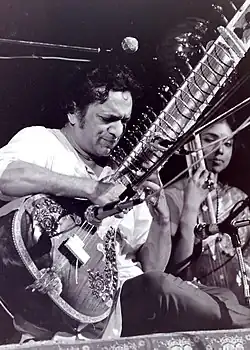
Ravi Shankar (Bengali pronunciation: [ˈrobi ˈʃɔŋkor]; born Robindro Shaunkor Chowdhury, sometimes spelled as Rabindra Shankar Chowdhury; 7 April 1920 – 11 December 2012) was an Indian sitarist and composer. A sitar virtuoso, he became the world's best-known expert of Indian classical music in the second half of the 20th century, and influenced many musicians in India and throughout the world. Shankar was awarded India's highest civilian honour, the Bharat Ratna, in 1999. He is also the father of American singer Norah Jones and British-American musician and sitar player Anoushka Shankar.
Shankar was born to a Bengali family in India, and spent his youth as a dancer touring India and Europe with the dance group of his brother Uday Shankar. At age 18, he gave up dancing to pursue a career in music, studying the sitar for seven years under court musician Allauddin Khan. After finishing his studies in 1944, Shankar worked as a composer, creating the music for the Apu Trilogy by Satyajit Ray, and was music director of All India Radio, New Delhi, from 1949 to 1956. He was nominated for the Academy Award for Best Original Score for scoring the blockbuster Gandhi (1982). (Full article...) -
 Image 8
Image 8 Portrait from 1846
Portrait from 1846
Jakob Ludwig Felix Mendelssohn Bartholdy (3 February 1809 – 4 November 1847), widely known as Felix Mendelssohn, was a German composer, pianist, organist and conductor of the early Romantic period. Mendelssohn's compositions include symphonies, concertos, piano music, organ music and chamber music. His best-known works include the overture and incidental music for A Midsummer Night's Dream (which includes his "Wedding March"), the Italian and Scottish Symphonies, the oratorios St. Paul and Elijah, the Hebrides Overture, the mature Violin Concerto, the String Octet, and the melody used in the Christmas carol "Hark! The Herald Angels Sing". Mendelssohn's Songs Without Words are his most famous solo piano compositions.
Mendelssohn's grandfather was the Jewish philosopher Moses Mendelssohn, but Felix was initially raised without religion until he was baptised aged seven into the Reformed Christian church. He was recognised early as a musical prodigy, but his parents were cautious and did not seek to capitalise on his talent. His sister Fanny Mendelssohn received a similar musical education and was a talented composer and pianist in her own right; some of her early songs were published under her brother's name and her Easter Sonata was for a time mistakenly attributed to him after being lost and rediscovered in the 1970s. (Full article...) -
 Image 9
Image 9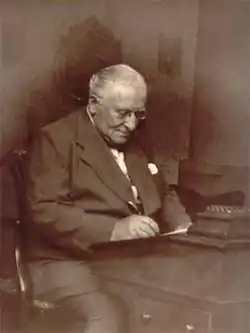
Albert William Ketèlbey (/kəˈtɛlbi/; born Ketelbey; 9 August 1875 – 26 November 1959) was an English composer, conductor and pianist, best known for his short pieces of light orchestral music. He was born in Birmingham and moved to London in 1889 to study at Trinity College of Music. After a brilliant studentship he did not pursue the classical career predicted for him, becoming musical director of the Vaudeville Theatre before gaining fame as a composer of light music and as a conductor of his own works.
For many years Ketèlbey worked for a series of music publishers, including Chappell & Co and the Columbia Graphophone Company, making arrangements for smaller orchestras, a period in which he learned to write fluent and popular music. He also found great success writing music for silent films until the advent of talking films in the late 1920s. (Full article...) -
![Image 10 Lutosławski in 1992 Witold Roman Lutosławski (Polish: [ˈvitɔld lutɔˈswafski] ⓘ; 25 January 1913 – 7 February 1994) was a Polish composer and conductor. Among the major composers of 20th-century classical music, he is "generally regarded as the most significant Polish composer since Szymanowski, and possibly the greatest Polish composer since Chopin". His compositions—of which he was a notable conductor—include representatives of most traditional genres, aside from opera: symphonies, concertos, orchestral song cycles, other orchestral works, and chamber works. Among his best known works are his four symphonies, the Variations on a Theme by Paganini (1941), the Concerto for Orchestra (1954), and his cello concerto (1970). During his youth, Lutosławski studied piano and composition in Warsaw. His early works were influenced by Polish folk music and demonstrated a wide range of rich atmospheric textures. His folk-inspired music includes the Concerto for Orchestra (1954)—which first brought him international renown—and Dance Preludes (1955), which he described as a "farewell to folklore". From the late 1950s he began developing new, characteristic composition techniques. He introduced limited aleatoric elements, while retaining tight control of his music's material, architecture, and performance. He also evolved his practice of building harmonies from small groups of musical intervals. (Full article...)](./_assets_/Blank.png) Image 10
Image 10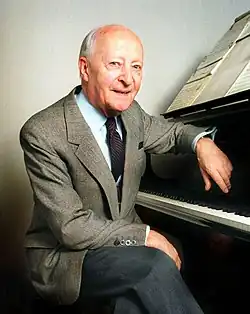 Lutosławski in 1992
Lutosławski in 1992
Witold Roman Lutosławski (Polish: [ˈvitɔld lutɔˈswafski] ⓘ; 25 January 1913 – 7 February 1994) was a Polish composer and conductor. Among the major composers of 20th-century classical music, he is "generally regarded as the most significant Polish composer since Szymanowski, and possibly the greatest Polish composer since Chopin". His compositions—of which he was a notable conductor—include representatives of most traditional genres, aside from opera: symphonies, concertos, orchestral song cycles, other orchestral works, and chamber works. Among his best known works are his four symphonies, the Variations on a Theme by Paganini (1941), the Concerto for Orchestra (1954), and his cello concerto (1970).
During his youth, Lutosławski studied piano and composition in Warsaw. His early works were influenced by Polish folk music and demonstrated a wide range of rich atmospheric textures. His folk-inspired music includes the Concerto for Orchestra (1954)—which first brought him international renown—and Dance Preludes (1955), which he described as a "farewell to folklore". From the late 1950s he began developing new, characteristic composition techniques. He introduced limited aleatoric elements, while retaining tight control of his music's material, architecture, and performance. He also evolved his practice of building harmonies from small groups of musical intervals. (Full article...) -
 Image 11
Image 11
Percy Aldridge Grainger (born George Percy Grainger; 8 July 1882 – 20 February 1961) was an Australian-born composer, arranger and pianist who moved to the United States in 1914 and became an American citizen in 1918. In the course of a long and innovative career he played a prominent role in the revival of interest in British folk music in the early years of the 20th century. Although much of his work was experimental and unusual, the piece with which he is most generally associated is his piano arrangement of the folk-dance tune "Country Gardens".
Grainger left Australia at the age of 13 to attend the Hoch Conservatory in Frankfurt. Between 1901 and 1914 he was based in London, where he established himself first as a society pianist and later as a concert performer, composer, and collector of original folk melodies. As his reputation grew he met many of the significant figures in European music, forming important friendships with Frederick Delius and Edvard Grieg. He became a champion of Nordic music and culture, his enthusiasm for which he often expressed in private letters, sometimes in crudely racialist or anti-Semitic terms. (Full article...) -
 Image 12Yasunori Mitsuda (光田 康典, Mitsuda Yasunori; born January 21, 1972) is a Japanese composer. He is best known for his work in video games, primarily for the Chrono, Xeno, Shadow Hearts, and Inazuma Eleven franchises, among various others. Mitsuda began composing music for his own games in high school, later attending a music college in Tokyo. While still a student, he was granted an intern position at the game development studio Wolf Team.
Image 12Yasunori Mitsuda (光田 康典, Mitsuda Yasunori; born January 21, 1972) is a Japanese composer. He is best known for his work in video games, primarily for the Chrono, Xeno, Shadow Hearts, and Inazuma Eleven franchises, among various others. Mitsuda began composing music for his own games in high school, later attending a music college in Tokyo. While still a student, he was granted an intern position at the game development studio Wolf Team..jpg) Mitsuda in 2019
Mitsuda in 2019
Mitsuda joined Square upon graduation in 1992 and worked there as a sound effects designer for two years before telling Square's vice president Hironobu Sakaguchi he would quit unless he could write music for their games. Shortly after, Sakaguchi assigned him to work on the soundtrack for Chrono Trigger (1995), whose music has since been cited as among the best in video games. (Full article...) -
![Image 13 Sousa in 1922 John Philip Sousa (/ˈsuːzə, ˈsuːsə/ SOO-zə, SOO-sə, Portuguese: [ˈso(w)zɐ]; November 6, 1854 – March 6, 1932) was an American composer and conductor of the late Romantic era known primarily for American military marches. He is known as "The March King" or the "American March King", to distinguish him from his British counterpart Kenneth J. Alford. Among Sousa's best-known marches are "The Stars and Stripes Forever" (National March of the United States of America), "Semper Fidelis" (official march of the United States Marine Corps), "The Liberty Bell", "The Thunderer", and "The Washington Post". Sousa began his career playing violin and studying music theory and composition under John Esputa and George Felix Benkert. Sousa's father enlisted him in the United States Marine Band as an apprentice in 1868. Sousa left the band in 1875, and over the next five years, he performed as a violinist and learned to conduct. In 1880, Sousa rejoined the Marine Band and served there for 12 years as director. In 1892, he left the Marine Band and organized the civilian Sousa Band. From 1880 until his death, Sousa focused exclusively on conducting and writing music. He aided in the development of the sousaphone, a large brass instrument similar to the helicon and tuba. (Full article...)](./_assets_/Blank.png) Image 13
Image 13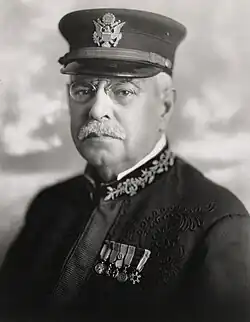 Sousa in 1922
Sousa in 1922
John Philip Sousa (/ˈsuːzə, ˈsuːsə/ SOO-zə, SOO-sə, Portuguese: [ˈso(w)zɐ]; November 6, 1854 – March 6, 1932) was an American composer and conductor of the late Romantic era known primarily for American military marches. He is known as "The March King" or the "American March King", to distinguish him from his British counterpart Kenneth J. Alford. Among Sousa's best-known marches are "The Stars and Stripes Forever" (National March of the United States of America), "Semper Fidelis" (official march of the United States Marine Corps), "The Liberty Bell", "The Thunderer", and "The Washington Post".
Sousa began his career playing violin and studying music theory and composition under John Esputa and George Felix Benkert. Sousa's father enlisted him in the United States Marine Band as an apprentice in 1868. Sousa left the band in 1875, and over the next five years, he performed as a violinist and learned to conduct. In 1880, Sousa rejoined the Marine Band and served there for 12 years as director. In 1892, he left the Marine Band and organized the civilian Sousa Band. From 1880 until his death, Sousa focused exclusively on conducting and writing music. He aided in the development of the sousaphone, a large brass instrument similar to the helicon and tuba. (Full article...) -
 Image 14
Image 14.jpg) Guto Pryderi Puw (2018)
Guto Pryderi Puw (2018)
Guto Pryderi Puw (born 1971) is a Welsh composer, university lecturer and conductor. He is considered to be one of the most prominent Welsh composers of his generation and a key figure in current Welsh music. Puw's music has been broadcast on BBC Radio 3 and been featured on television programmes for the BBC and S4C. He has twice been awarded the Composer's Medal at the National Eisteddfod.
Puw's works include pieces for unusual combinations of instruments, such as a tuba quartet or a trio consisting of harp, cello and double-bass, as well as more traditional forces such as solo baritone and piano, choir or orchestra. He was associated with the BBC National Orchestra of Wales as its Resident Composer, the first holder of this title, from 2006 to 2010. Puw's own Welsh identity is a recurrent theme in his music: some of his pieces set Welsh-language poetry to music and one of his pieces, Reservoirs, is written about the flooding of Welsh valleys to provide water for England. (Full article...) -
 Image 15
Image 15Top: Pyotr Ilyich Tchaikovsky. Bottom (left to right): Nikolai Rimsky-Korsakov, Alexander Glazunov and Anatoly Lyadov
Pyotr Ilyich Tchaikovsky's relations with the group of composers known as the Belyayev circle, which lasted from 1887 until Tchaikovsky's death in 1893, influenced all of their music and briefly helped shape the next generation of Russian composers. This group was named after timber merchant Mitrofan Belyayev, an amateur musician who became an influential music patron and publisher after he had taken an interest in Alexander Glazunov's work. By 1887, Tchaikovsky was firmly established as one of the leading composers in Russia. A favorite of Tsar Alexander III, he was widely regarded as a national treasure. He was in demand as a guest conductor in Russia and Western Europe, and in 1890 visited the United States in the same capacity. By contrast, the fortunes of the nationalistic group of composers known as The Five, which preceded the Belyayev circle, had waned, and the group had long since dispersed; of its members, only Nikolai Rimsky-Korsakov remained fully active as a composer. Now a professor of musical composition and orchestration at the Saint Petersburg Conservatory, Rimsky-Korsakov had become a firm believer in the Western-based compositional training that had been once frowned upon by the group.
As a result of the time Tchaikovsky spent with the Belyayev circle's leading composers—Glazunov, Anatoly Lyadov and Rimsky-Korsakov—the somewhat fraught relationship he had previously endured with The Five would eventually meld into something more harmonious. Tchaikovsky's friendship with these men gave him increased confidence in his own abilities as a composer, while his music encouraged Glazunov to broaden his artistic outlook past the nationalist agenda and to compose along more universal themes. This influence grew to the point that Glazunov's Third Symphony became known as the "anti-kuchist" symphony of his oeuvre ("kuchist" refers to "kuchka", the shortened Russian name for The Five) and shared several stylistic fingerprints with Tchaikovsky's later symphonies. Nor was Glazunov the only composer so influenced. Rimsky-Korsakov wrote about the Belyayev composers' "worship of Tchaikovsky and ... tendency toward eclecticism" that became prevalent during this period, along with a predilection toward "Italian-French music of the time of wig and farthingale" (that is, of the 18th Century) typified in Tchaikovsky's late operas The Queen of Spades and Iolanta. (Full article...)
Did you know (auto-generated) -

- ... that WFMT classical music radio host Don Tait owned such a large collection of recordings that he had to buy a house and have its floor reinforced to accommodate the weight?
- ... that the choral music of Artemy Vedel, who is regarded as one of the Golden Three composers of 18th-century Ukrainian classical music, was censored but performed from handwritten copies?
- ... that opera singer Charles Holland spent much of his career in Europe as opportunities in classical music for African Americans were limited?
- ... that gas lighting inspired Stephen Gunzenhauser to start a classical music festival?
- ... that in 1994, Anthony Pople created two computer programs to analyse classical music?
Selected image
-
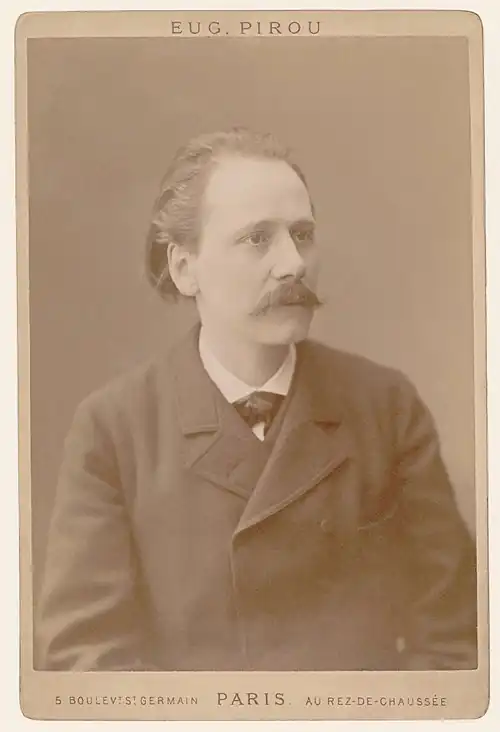 Image 1Photograph credit: Eugène Pirou; restored by Adam CuerdenJules Massenet (12 May 1842 – 13 August 1912) was a French composer of the Romantic era, best known for his operas. Between 1867 and his death, he wrote more than forty stage works in a wide variety of styles, from opéra comique to grand depictions of classical myths, romantic comedies and lyric dramas, as well as oratorios, cantatas and ballets. Massenet had a good sense of the theatre and of what would succeed with the Parisian public. Despite some miscalculations, he produced a series of successes that made him the leading opera composer in France in the late 19th and early 20th centuries. By the time of his death, he was regarded as old-fashioned; his works, however, began to be favourably reassessed during the mid-20th century, and many have since been staged and recorded. This photograph of Massenet was taken by French photographer Eugène Pirou in 1875.
Image 1Photograph credit: Eugène Pirou; restored by Adam CuerdenJules Massenet (12 May 1842 – 13 August 1912) was a French composer of the Romantic era, best known for his operas. Between 1867 and his death, he wrote more than forty stage works in a wide variety of styles, from opéra comique to grand depictions of classical myths, romantic comedies and lyric dramas, as well as oratorios, cantatas and ballets. Massenet had a good sense of the theatre and of what would succeed with the Parisian public. Despite some miscalculations, he produced a series of successes that made him the leading opera composer in France in the late 19th and early 20th centuries. By the time of his death, he was regarded as old-fashioned; his works, however, began to be favourably reassessed during the mid-20th century, and many have since been staged and recorded. This photograph of Massenet was taken by French photographer Eugène Pirou in 1875. -
 Image 2
Image 2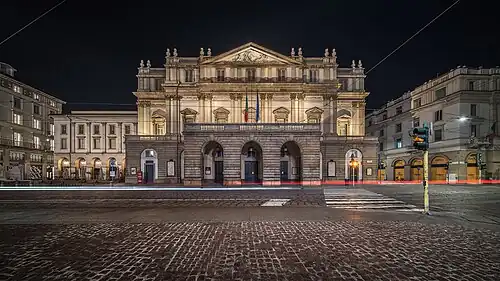 The Teatro alla Scala (or La Scala, as it is known), in Milan, Italy, is one of the world's most famous opera houses. The theatre was inaugurated on 3 August 1778, under the name Nuovo Regio Ducal Teatro alla Scala with Salieri's Europa riconosciuta.
The Teatro alla Scala (or La Scala, as it is known), in Milan, Italy, is one of the world's most famous opera houses. The theatre was inaugurated on 3 August 1778, under the name Nuovo Regio Ducal Teatro alla Scala with Salieri's Europa riconosciuta. -
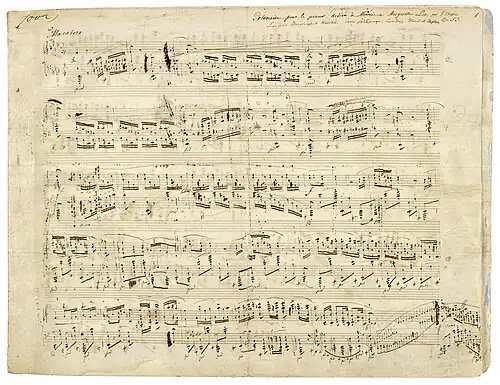 Image 3Sheet music for the Polonaise in A-flat major, Op. 53, a solo piano piece written by Frédéric Chopin in 1842. This work is one of Chopin's most admired compositions and has long been a favorite of the classical piano repertoire. The piece, which is very difficult, requires exceptional pianistic skills and great virtuosity to be interpreted. A typical performance of the polonaise lasts seven minutes.
Image 3Sheet music for the Polonaise in A-flat major, Op. 53, a solo piano piece written by Frédéric Chopin in 1842. This work is one of Chopin's most admired compositions and has long been a favorite of the classical piano repertoire. The piece, which is very difficult, requires exceptional pianistic skills and great virtuosity to be interpreted. A typical performance of the polonaise lasts seven minutes. -
 Image 4
Image 4 Stradivarius is one of the violins, violas, cellos and other string instruments built by members of the Italian Stradivari family, particularly Antonio Stradivari.
Stradivarius is one of the violins, violas, cellos and other string instruments built by members of the Italian Stradivari family, particularly Antonio Stradivari. -
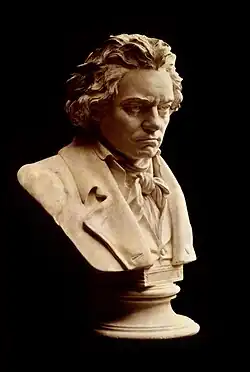 Image 5Photo: W. J. Mayer; Restoration: Lise BroerA bust of the German composer and pianist Ludwig van Beethoven (1770–1827), made from his death mask. He was a crucial figure in the transitional period between the Classical and Romantic eras in Western classical music, and remains one of the most acclaimed and influential composers of all time. Born in Bonn, of the Electorate of Cologne and a part of the Holy Roman Empire of the German Nation in present-day Germany, he moved to Vienna in his early twenties and settled there, studying with Joseph Haydn and quickly gaining a reputation as a virtuoso pianist. His hearing began to deteriorate in the late 1790s, yet he continued to compose, conduct, and perform, even after becoming completely deaf.
Image 5Photo: W. J. Mayer; Restoration: Lise BroerA bust of the German composer and pianist Ludwig van Beethoven (1770–1827), made from his death mask. He was a crucial figure in the transitional period between the Classical and Romantic eras in Western classical music, and remains one of the most acclaimed and influential composers of all time. Born in Bonn, of the Electorate of Cologne and a part of the Holy Roman Empire of the German Nation in present-day Germany, he moved to Vienna in his early twenties and settled there, studying with Joseph Haydn and quickly gaining a reputation as a virtuoso pianist. His hearing began to deteriorate in the late 1790s, yet he continued to compose, conduct, and perform, even after becoming completely deaf. -
 Image 6
Image 6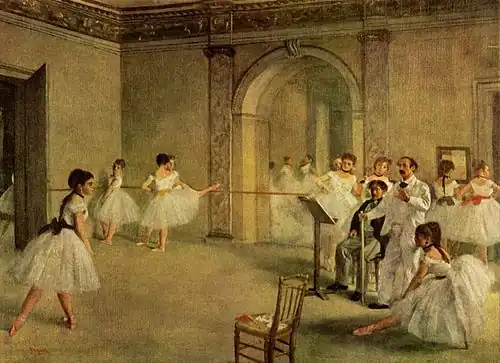 Ballet is a formalized form of dance with its origins in the French court, further developed in France and Russia as a concert dance form.
Ballet is a formalized form of dance with its origins in the French court, further developed in France and Russia as a concert dance form. -
 Image 7Painting: Thomas GainsboroughJohann Christian Bach (5 September 1735 – 1 January 1782) was a composer of the Classical era, the eighteenth child of Johann Sebastian Bach, and the youngest of his eleven sons. Bach was taught by his father and then, after the latter's death, by his half-brother C. P. E. Bach. Bach moved to Italy in 1754, and then to London in 1762, where he became known as the "London Bach". Bach's compositions include eleven operas, as well as chamber music, orchestral music and compositions for keyboard music. In 1764 Bach met Wolfgang Amadeus Mozart, who was eight at the time, and spent five months teaching him composition. He had considerable influence on Mozart, and was later described by scholars as his "only, true teacher".
Image 7Painting: Thomas GainsboroughJohann Christian Bach (5 September 1735 – 1 January 1782) was a composer of the Classical era, the eighteenth child of Johann Sebastian Bach, and the youngest of his eleven sons. Bach was taught by his father and then, after the latter's death, by his half-brother C. P. E. Bach. Bach moved to Italy in 1754, and then to London in 1762, where he became known as the "London Bach". Bach's compositions include eleven operas, as well as chamber music, orchestral music and compositions for keyboard music. In 1764 Bach met Wolfgang Amadeus Mozart, who was eight at the time, and spent five months teaching him composition. He had considerable influence on Mozart, and was later described by scholars as his "only, true teacher".
This portrait of Bach was painted in 1776 by Thomas Gainsborough, as part of a collection started by Bach's former teacher Padre Martini. It now hangs in the National Portrait Gallery, London. -
 Image 8Photo: Guillaume PiolleThe anatomy of a Périnet piston valve, this one taken from a B♭ trumpet. When depressed, the valve diverts the air stream through additional tubing, thus lengthening the instrument and lowering the harmonic series on which the instrument is vibrating (i.e., it lowers the pitch). Trumpets generally use three valves, with some variations, such as a piccolo trumpet, having four. When used singly or in combination, the valves make the instrument fully chromatic, or capable of playing all twelve pitches of classical music. Trumpets may also use rotary valves instead.
Image 8Photo: Guillaume PiolleThe anatomy of a Périnet piston valve, this one taken from a B♭ trumpet. When depressed, the valve diverts the air stream through additional tubing, thus lengthening the instrument and lowering the harmonic series on which the instrument is vibrating (i.e., it lowers the pitch). Trumpets generally use three valves, with some variations, such as a piccolo trumpet, having four. When used singly or in combination, the valves make the instrument fully chromatic, or capable of playing all twelve pitches of classical music. Trumpets may also use rotary valves instead. -
.jpg) Image 9Photograph credit: William P. Gottlieb; restored by Adam CuerdenBilly Strayhorn (November 29, 1915 – May 31, 1967) was an American jazz composer, pianist, lyricist, and arranger, best remembered for his long-time collaboration with bandleader and composer Duke Ellington that lasted nearly three decades. Though classical music was Strayhorn's first love, his ambition to become a classical composer went unrealized because of the harsh reality of a black man trying to make his way in the world of classical music, which at that time was almost completely white. He was introduced to the music of pianists like Art Tatum and Teddy Wilson at age 19, and the artistic influence of these musicians guided him into the realm of jazz, where he remained for the rest of his life. This photograph of Strayhorn was taken by William P. Gottlieb in the 1940s.
Image 9Photograph credit: William P. Gottlieb; restored by Adam CuerdenBilly Strayhorn (November 29, 1915 – May 31, 1967) was an American jazz composer, pianist, lyricist, and arranger, best remembered for his long-time collaboration with bandleader and composer Duke Ellington that lasted nearly three decades. Though classical music was Strayhorn's first love, his ambition to become a classical composer went unrealized because of the harsh reality of a black man trying to make his way in the world of classical music, which at that time was almost completely white. He was introduced to the music of pianists like Art Tatum and Teddy Wilson at age 19, and the artistic influence of these musicians guided him into the realm of jazz, where he remained for the rest of his life. This photograph of Strayhorn was taken by William P. Gottlieb in the 1940s. -
 Image 10Photograph: David IliffThe Royal Albert Hall is a concert hall, seating a maximum of 5,272, on the northern edge of South Kensington, London. Constructed beginning in 1867, the hall was inaugurated on 29 March 1871. Since 1941 it has held The Proms, an eight-week summer season of daily orchestral classical music concerts and other events.
Image 10Photograph: David IliffThe Royal Albert Hall is a concert hall, seating a maximum of 5,272, on the northern edge of South Kensington, London. Constructed beginning in 1867, the hall was inaugurated on 29 March 1871. Since 1941 it has held The Proms, an eight-week summer season of daily orchestral classical music concerts and other events. -
 Image 11
Image 11
A picture of the first theatre drawn shortly before it burned down in 1808.
The Royal Opera House is an opera house and major performing arts venue in the London district of Covent Garden. The large building, often referred to as simply "Covent Garden", is the home of The Royal Opera, The Royal Ballet and the Orchestra of the Royal Opera House.
Topics
Things you can do
 |
Here are some tasks awaiting attention:
|
Categories

Associated Wikimedia
The following Wikimedia Foundation sister projects provide more on this subject:
-
Commons
Free media repository -
Wikibooks
Free textbooks and manuals -
Wikidata
Free knowledge base -
Wikinews
Free-content news -
Wikiquote
Collection of quotations -
Wikisource
Free-content library -
Wikiversity
Free learning tools -
Wiktionary
Dictionary and thesaurus
-
 List of all portals
List of all portals -

-

-

-

-

-

-

-

-

-
 Random portal
Random portal -
 WikiProject Portals
WikiProject Portals







